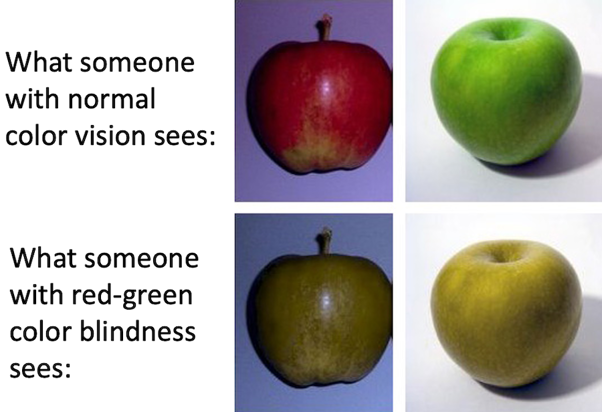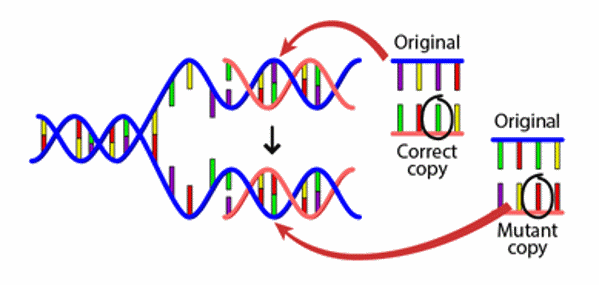
Are there ways for a boy to end up NOT colorblind when his mom is colorblind?
January 12, 2011

- Related Topics:
- Color vision deficiency,
- X linked inheritance,
- Carrier
A curious adult from California asks:
"Are there ways for a boy to end up NOT colorblind when his mom is colorblind and his dad isn't?"
When it comes to what genes can do, almost anything is possible! So yes, there are definitely ways for a boy NOT to be colorblind even though his mom is.
For example, sometimes people are colorblind because of something that happened to their eyes at some point during development or later. These folks are colorblind but do not carry the gene for it. A mother who is colorblind for this reason would not pass it on to her son.
There are also a few different types of colorblindness, which have different inheritance patterns. It wouldn’t be unusual for a woman with blue-yellow color blindness to have an unaffected son. The same is true for some other types of color vision deficiencies.
But it is unusual for a woman with red-green color blindness to have a non-colorblind son. And since this is the most common type of color vision problem, it’s often what people mean when they talk about colorblindness. It's also the kind that's more common in boys than girls. About 8% of boys have it compared to only 0.5% of girls.
But as we’ll get into, “unusual” is not the same thing as “impossible”.
Red-green colorblindness
Red-green colorblindness is a recessive trait. This means that to be colorblind, a person can't have any working copies of the gene involved. As long as there's one working gene, they will have normal color vision.
Red-green colorblindness is caused by a non-working gene on the X chromosome. As you probably know, most boys have an X and a Y chromosome while most girls have two X chromosomes. This makes for some tricky genetics that would seem to make it impossible for a woman to have a son who is not colorblind.

If a woman is colorblind, that means she has the nonworking gene on both X chromosomes. Since sons almost always get their only X chromosome from their mom, chances are they will be colorblind too.
But nothing's perfect and that includes the way in which genes get passed down from parents to kids. I can think of a few ways to get a working color-vision gene in this case.
Skewed X inactivation
Remember, women have two X chromosomes but only use one -- the other X is shut off. Because of the way this "X-inactivation" works, some cells end up with one of the X's shut off and the rest of the cells have the other X shut off.
This is why women who carry the colorblindness trait actually are a bit colorblind. Some of their eye cells can not tell red from green.
The idea behind skewed X inactivation is that sometimes one X happens to get shut off more often by chance in certain cells. If the colorblind X happened to stay on in the mother, then she would be colorblind even though she was a carrier.
If the woman was colorblind due to skewed X inactivation, she could pass on a non-colorblind version of the X to her son. (Click here to learn more about skewed X inactivation.)
A mutation that “fixes” the gene?
Genes usually don't work because of certain specific differences in them. To get a gene working again, a random, rare DNA change (or mutation) has to happen in the exact right spot. Because we are talking about a random change in over 6 billion letters of code here, this is not very common.
But it could theoretically happen. (And we’ve talked about this sort of rare event for other “impossible” events before.)

An X chromosome from dad?
It also could be possible for the son to inherit a working copy from dad. While this may seem impossible since boys get Y's and not X's from their dad, there are a couple of ways it can happen.
Sometimes dads can pass both an X and a Y chromosome to their son. In that case, the son usually has two X's and one Y. This is true for around 1 in 500 men so it is more common than you might think.
Another possibility is for part of the X chromosome to stick to another chromosome. Now that chromosome has the color vision gene on it instead of the X. If this man had a colorblind wife, they could have colorblind daughters and sons that could tell red from green. These kids would be impossible by standard genetics!
A future possibility: gene therapy
Getting an extra copy of the color vision gene from dad points to how colorblindness may one day be cured -- with gene therapy. In gene therapy, scientists add back a working gene to someone whose gene is broken. The working gene is able to compensate for the broken one(s).
Although it's hard to pull off for most diseases, scientists have used gene therapy to correct colorblindness in mice and in monkeys. Ultimately, they might be able to use gene therapy to cure not just colorblindness, but a range of other vision disorders in humans too!

Getting Extra Genes
For the rest of the answer, I'll focus a bit on how you could get a working copy of this gene from dad.
As you know, each of us has 23 pairs of chromosomes. We have 22 pairs of autosomes and one pair of sex chromosomes (either XX or XY).
We couldn't just combine two everyday cells to make a new person. This person would have two sets of 22 autosome pairs and four sex chromosomes. And the next generation would have twice as many. And so on.
Obviously this would never work. Which is why nature has come up with a way for each generation to have the same number of chromosomes. This way is called meiosis.
In meiosis, every egg gets half of mom's chromosomes and every sperm gets half of dad's chromosomes. Since mom has two X chromosomes, all her eggs get an X chromosome. But half of dad's sperms get an X and the other half get a Y.
Separating pairs of chromosomes so that every egg (or sperm) gets only one of each pair is tricky. More often than you think, cells get this wrong and the pairs stick together when going into daughter cells. Or pieces of chromosomes get shuffled around a bit. So one daughter cell can get part of or a whole extra chromosome and the other cell ends up with less.
Imagine this happening with the X and Y chromosomes. If it happens in the father's cells, one sperm cell would end up with no X chromosome, but the other one would have both an X and a Y. If this second sperm were to combine with a normal egg during fertilization, the embryo would have two X chromosomes and one Y. So any defects on the mother's X chromosome (like colorblindness) wouldn't be seen.
Not Always a Good Thing
Although picking up an extra chromosome from another cell and fixing defective genes with it sounds very convenient, it usually causes pretty serious genetic problems. The effects of having an extra chromosome (called a “trisomy”), depend on the genes the chromosome carries. Most trisomies result in miscarriages or death. Some like trisomy 21 (Down's syndrome) or trisomy 13 (Patau's disease) can cause developmental disorders at various stages of life. And some, like having an extra X or Y chromosome can have almost no effect.
The X and Y chromosomes are different from the autosomes for a couple of reasons. First off, cells are very good at shutting off most of any extra X chromosomes. And second, the Y chromosome has almost nothing on it, so the extra ones don't matter a whole lot.
What this means for us here is that a male with an extra X chromosome (called XXY trisomy, or Klinefelter's syndrome) has pretty mild symptoms. In fact, of the one in 500 men who carry an extra X, only about half of them (1 in 1000 men) have any effects whatsoever.
As you can tell, genetics has lots of exceptions to all those rules we learn in school. Most sons of colorblind women will be colorblind too. But a few will be able to tell rubies from emeralds just fine.

Author: Dr. Jyoti Madhusoodanan
Dr. Madhusoodanan wrote this article while participating in the Stanford at the Tech program.
 Skip Navigation
Skip Navigation
